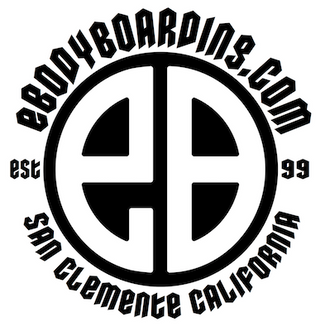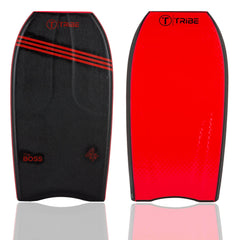8 steps to choosing the right bodyboard
#1 - What Size Bodyboard Should I Get?
Your Height: How do you pick the correct bodyboard length? The length of your bodyboard depends on your height for the most part. Back in the day, traditional bodyboards were all 42". Fortunately today they come in many sizes to fit everyone out there from kids to adults and even bigger riders!
With some riders, much of your “height” is in your upper or lower body (ie: long legs/short torso, or vice versa), but the general rule of thumb is, if you are a SERIOUS bodyboarder, meaning you’re wearing fins and making your way out to where the waves are beginning to break, and you’re riding, or aspiring to ride along the unbroken part of the wave, then the length of your board should come up to roughly the height of your belly button off the ground.
However, while this might be a good place to start, things like your ability level, weight, type of waves you ride and even the water temperature are also important factors in determining the appropriate bodyboard length (see below).
If you are going to be mostly riding the white water with no swimfins or maybe you are buying for a quickly-growing child who is not a serious rider, then consider getting a slightly longer board for more planing surface, stability and speed. The length of the board is not as crucial, as long as the board isn’t too SHORT for the rider.
If you are a serious rider, wearing swimfins, then if the board is too long, too much of your body will be up on the board, and not enough of your legs/swimfins will be in the water. This causes two issues:
- You won’t be able to sink your swimfins to kick (see our YouTube video on how to kick with swimfins).
- You won’t have enough leg/swimfin in the water to help with steering and control while riding the wave.
Don’t get too hung up on the recommendations if you ride a longer or shorter board and are happy with it. Use our Bodyboard Size Chart below for a starting point.
Bodyboard Size Chart
| Board Length | Your Weight | Your Height | Size that also work: |
| 36” | 40-90 lbs. | 4’ - 4’10” | 34-38” boards |
| 38” | 65-100 lbs. | 4'8 - 5' | 36-39” boards |
| 39" | 85-115 lbs. | 4'6" - 5'2" | 38-40” boards |
| 40" | 110-140 lbs. | 5'3"- 5'6" | 39-41” boards |
| 41" | 125-170 lbs. | 5'6" - 5'8" | 40-41.5” boards |
| 42" | 145-180 lbs. | 5'7"-6'0" | 41.5-42.5” boards |
| 43" | 170-210 lbs. | 6'1"-6'3" | 42.75-43.5 boards |
| 44" | 180-250 lbs. | 6'2"-6'4" | 43.5-44.5 boards |
| 45" | 195-270 lbs. | 6'3" - 6'6" | 44.5-45.5 boards |
| 46" | 220 lbs. + | 6'4" + | 45.5-48” boards |
Shop Bodyboards by Length
#2 - How wide and thick should my bodyboard be? Should I get a "high volume" bodyboard
Your weight: After determing the length of your bodyboard, your weight plays a factor, particularly if you are on the larger side. You don't want to be riding a sinking ship. Luckily there are some more buoyant options out there for the heavier rider. The volume of a board refers to, in simple terms, how buoyant that board is going to be for the rider. It goes to follow that a heavier rider will need a board with more volume. The board needs to be sized correctly in length, width and thickness to float you on top of the water. The extra foam will help you get into waves, plane through dead spots and give you the speed and performance you need. We have certain models that are labeled “high volume” that fit these needs. If you are over 180 lbs, these models are well suited to your weight class.
Additionally, consider the following factors when deciding on a bodyboard size:
- If you're riding primarily in the whitewash, pick a board on the longer end of the size range.
- If you're riding is mostly bigger waves, consider a bodyboard on the shorter end of your optimal size range.
- If you are a more of an advanced rider consider a shorter board for maneuverability.
- If you are a beginner, aim for a longer board in your size range.
- If you are on the heavier end of the scale, look for thicker/wider high volume board, not necessarily longer.
Bodyboard Brands
Bodyboard Shapes
There are many shapes floating around the bodyboard world these days from old-school BSD to new-school streamlined speed machines. While some bodyboards will work nearly anywhere, there are a variety of shapes and designs that are dialed in for making the most out of specific conditions or riding styles. Brands are consistently evolving and experimenting with their boards and offer new templates or designs nearly every year. Which template you choose is entirely up to your personal preference and many bodyboarders have different boards for the different types of riding or the different waves they ride.
Here is a little bit more info on more specific bodyboard designs:
Softer Flex
Softer-flex bodyboards (typically EPS and PE bodyboards) are going to be more forgiving and be easier to turn. A soft flex is good for beginners, and riders with lower body weights. Softer-flex bodyboards tend to be a little slower in smaller sized waves but can be helpful in hollow or bigger waves with power.
Stiffer Flex
Stiffe-flex bodyboards are usually built for speed. Stiff boards can be great for warmer water, smaller waves and bigger riders. Stiffness is tough for lightweight riders as they have a tougher time turning the board and can have problems with nose diving.
Women's Bodyboards
Some bodyboard companies simply sized down men’s bodyboards and applied pretty pink graphics to them. Not anymore! Companies have created bodyboards specifically for women based on their feedback and needs. Women’s bodies are different than men. Since women tend to have less body mass and smaller frames than men of the same height, women’s bodyboards tend to have thinner rails, softer flex and come in smaller sizes.
Kids' Bodyboards
As much as you want to buy a bodyboard your child can grow into, it is important to find a bodyboard that will work for him or her now. Do you want your kid to love bodyboarding? We thought so! The correct size bodyboard will help your child progress faster and have a lot more fun in the process. Kids’ bodyboards are typically smaller and less stiff than adult bodyboards making it easier for kids to initiate turns, duckdive and learn to ride. For more information, check out our kids bodyboard size guide.
Check out our other guides:
-
Bodyboard - Kids' Bodyboard Size Chart
-
Bodyboard Bags- How to choose
-
Bodyboarding- How to get started
-
Travel- How to fly with Bodyboards & Airline Baggage Policies
-
Socks- How to choose swimfin socks or booties
Learn More About Our Favorite Gear
The Best Bodyboards
The Best Women's Bodyboards
The Best Kids Bodyboards
The Best Dropknee Bodyboards
The Best Beginner Bodyboards
The Best Bodyboarding Swimfins
The Best Bodyboarding Leashes
This is eBodyboarding. We are a bodyboarding retailer with a warehouse store in San Clemente, California. Our goal is to provide you with all the information you need to make your purchase easy and your riding amazing.
Jay and Vicki are the owners and they like to travel to remote places across the globe in search of epic waves on our Travel Tours. Or, if you prefer to travel on your own, check out our bodyboarding travel guides.
Still have questions? We are all bodyboarders here so if you need more help give our team a call at 949-361-0848, during our business hours. We can help you find the right gear setup to fit your needs.






